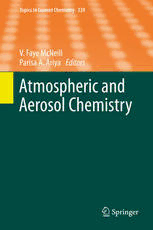
Atmospheric and Aerosol Chemistry PDF
Preview Atmospheric and Aerosol Chemistry
Topics in Current Chemistry 339 V. Faye McNeill Parisa A. Ariya Editors Atmospheric and Aerosol Chemistry 339 Topics in Current Chemistry EditorialBoard: K.N.Houk,LosAngeles,CA,USA C.A.Hunter,Sheffield,UK M.J.Krische,Austin,TX,USA J.-M.Lehn,Strasbourg,France S.V.Ley,Cambridge,UK M.Olivucci,Siena,Italy J.Thiem,Hamburg,Germany M.Venturi,Bologna,Italy P.Vogel,Lausanne,Switzerland C.-H.Wong,Taipei,Taiwan H.N.C.Wong,Shatin,HongKong Forfurthervolumes: http://www.springer.com/series/128 Aims and Scope TheseriesTopicsinCurrentChemistry presentscriticalreviews ofthepresent and futuretrendsinmodernchemicalresearch.Thescopeofcoverageincludesallareasof chemical science including the interfaces with related disciplines such as biology, medicineandmaterialsscience. Thegoalofeachthematicvolumeistogivethenon-specialistreader,whetherat theuniversityorinindustry,acomprehensiveoverviewofanareawherenewinsights areemergingthatareofinteresttolargerscientificaudience. Thuseachreviewwithinthevolumecriticallysurveysoneaspectofthattopicand placesitwithinthecontextofthevolumeasawhole.Themostsignificantdevelop- mentsofthelast5to10yearsshouldbepresented.Adescriptionofthelaboratory procedures involved is often useful to the reader. The coverage should not be exhaustiveindata,butshouldratherbeconceptual,concentratingonthemethodolog- icalthinkingthatwill allowthenon-specialistreaderto understandtheinformation presented. Discussionofpossiblefutureresearchdirectionsintheareaiswelcome. Reviewarticlesfortheindividualvolumesareinvitedbythevolumeeditors. Readership:researchchemistsatuniversitiesorinindustry,graduatestudents. V. Faye McNeill Parisa A. Ariya l Editors Atmospheric and Aerosol Chemistry With contributions by (cid:1) (cid:1) (cid:1) (cid:1) M. Ammann P.A. Ariya T. Bartels-Rausch B. D’Anna (cid:1) (cid:1) (cid:1) (cid:1) D.J. Donaldson N.M. Donahue N. Eltouny V. Faye (cid:1) (cid:1) (cid:1) (cid:1) C. George D. Heard H. Herrmann E.D. Hudson (cid:1) (cid:1) (cid:1) (cid:1) V. Kanthasamy G. Kos J.H. Kroll V.F. McNeill (cid:1) (cid:1) (cid:1) (cid:1) R. Mortazavi I. Riipinen A.L. Robinson N. Sareen (cid:1) (cid:1) (cid:1) (cid:1) (cid:1) A.N. Schwier J. Sun D. Stone E.R. Trump V. Vaida (cid:1) (cid:1) C. Weller L. Whalley C. Wilde Editors V.FayeMcNeill ParisaA.Ariya DepartmentofChemicalEngineering DepartmentofChemistryand ColumbiaUniversity DepartmentofAtmosphericand NewYork OceanicSciences USA McGillUniversity Montreal Que´bec Canada ISSN0340-1022 ISSN1436-5049(electronic) ISBN978-3-642-41214-1 ISBN978-3-642-41215-8(eBook) DOI10.1007/978-3-642-41215-8 SpringerHeidelbergNewYorkDordrechtLondon LibraryofCongressControlNumber:2013953216 #Springer-VerlagBerlinHeidelberg2014 Thisworkissubjecttocopyright.AllrightsarereservedbythePublisher,whetherthewholeorpartof the material is concerned, specifically the rights of translation, reprinting, reuse of illustrations, recitation,broadcasting,reproductiononmicrofilmsorinanyotherphysicalway,andtransmissionor informationstorageandretrieval,electronicadaptation,computersoftware,orbysimilarordissimilar methodologynowknownorhereafterdeveloped.Exemptedfromthislegalreservationarebriefexcerpts inconnectionwithreviewsorscholarlyanalysisormaterialsuppliedspecificallyforthepurposeofbeing enteredandexecutedonacomputersystem,forexclusiveusebythepurchaserofthework.Duplication ofthispublicationorpartsthereofispermittedonlyundertheprovisionsoftheCopyrightLawofthe Publisher’s location, in its current version, and permission for use must always be obtained from Springer.PermissionsforusemaybeobtainedthroughRightsLinkattheCopyrightClearanceCenter. ViolationsareliabletoprosecutionundertherespectiveCopyrightLaw. The use of general descriptive names, registered names, trademarks, service marks, etc. in this publicationdoesnotimply,evenintheabsenceofaspecificstatement,thatsuchnamesareexempt fromtherelevantprotectivelawsandregulationsandthereforefreeforgeneraluse. While the advice and information in this book are believed to be true and accurate at the date of publication,neithertheauthorsnortheeditorsnorthepublishercanacceptanylegalresponsibilityfor anyerrorsoromissionsthatmaybemade.Thepublishermakesnowarranty,expressorimplied,with respecttothematerialcontainedherein. Printedonacid-freepaper SpringerispartofSpringerScience+BusinessMedia(www.springer.com) Preface Understandingandmitigatingtheeffectsofhumanactivitiesonairqualityandthe earth’sclimateareamongthemostsignificantchallengesfacingmankindtodayand forfuturegenerations.Adetailedunderstandingofthemechanismsofatmospheric chemistry, and the physical and chemical processes leading to aerosol and cloud formation, is necessary for accurate predictions of future air quality and climate. Steps towards mitigation of pollutants at the source set the stage for smart policy decisions.Someofthefield’sleadersinatmosphericchemistry,inboththegasand theaerosolphases,provideinsightsinthisvolumeofTopicsinCurrentChemistry. Sunlight,andspecificallyitsabilitytobreakseveralchemicalbonds,isthemajor driving force of atmospheric chemistry, normally through generation of reactive radicals. In their chapter “Emerging Areas in Atmospheric Photochemistry,” George and co-authors review new concepts in long-wavelength photochemistry inthegasphase,incondensedphases,andatenvironmentalinterfaces. Isopreneemissionsarethehighestamongallnon-methanehydrocarbons.Their chemistry is critical for predicting atmospheric oxidant levels as well as organic aerosolloadings.Heardetal.intheirchapter“NewInsightsintotheTropospheric OxidationofIsoprene:CombiningFieldMeasurements,LaboratoryStudies,Chem- icalModelling,andQuantumTheory”reviewrecentadvancesinourunderstanding of the chemistry of isoprene in remote areas (i.e., regions of low NOx) driven by surprisingobservationsinthefield. Understanding aerosol volatility, i.e., the partitioning of chemical species be- tweenthegasandparticulatephases,isimportantinordertodetermineatmospheric aerosol loadings accurately. The volatility of organic aerosol species evolves throughouttheaerosol’slifetimeduetochemical“aging”intheoxidizingenviron- ment of the atmosphere. Likewise, the phase of an organic species influences the rate and mechanisms of oxidative aging. In their chapter, Donahue and coauthors reviewtheprinciplesbehindthelinkagesbetween“VolatilityandAgingofAtmo- sphericOrganicAerosol.” Oneofthemajorpredicamentsofevaluationofthephysical–chemicaltransfor- mationsofchemicalsintheearth’satmosphereistheircharacterizationatverylow v vi Preface detection limits. Bio-organic chemicals are ubiquitous in the earth’s atmosphere and at air–snow interfaces. Besides impacts on the oxidative potential of the atmosphere, aerosol–cloud interactions, and radiation, airborne biological sub- stancesplayvariousrolesinthetransmissionofdiseaseinhumansandinecosys- tems, and are linked to bio-terrorism. Ariya et al. explore existing techniques and methods applicable to the physical characterization of bio-organic matter, and which provide information on gases, liquids, and aerosols in the atmosphere and at snow–air interfaces. They evaluate their strengths and weaknesses, and foresee futuredirectionsinthedomain. Atmosphericaerosolparticlesserveanimportantroleinestablishingtheclimate and in the hydrological cycle as nuclei in the formation of cloud droplets. The relationship between an aerosol particle’s chemical composition and its ability to serve as a cloud condensation nucleus (CCN) is complex. Organic material, a ubiquitous component of tropospheric aerosols, is typically more hydrophobic andlesshygroscopic,andthereforelessCCNactive,thaninorganicsalts.However, many common aerosol organics are amphiphilic and therefore surface-active. Surface-active organics can lower aerosol surface tension, thereby enhancing CCNactivation.Anorganicsurfacefilmcanalsoactasakineticbarrierforuptake of water or reactive gases to the aerosol, or serve as a nucleus for freezing in aqueousdroplets.Intheirchapter,McNeilletal.reviewthesourcesandimpactsof “Surface-ActiveOrganicsinAtmosphericAerosols.” NewYork,NY V.FayeMcNeill Montreal,QC ParisaA.Ariya Contents EmergingAreasinAtmosphericPhotochemistry ........................... 1 ChristianGeorge,BarbaraD’Anna,HartmutHerrmann, ChristianWeller,VeronicaVaida,D.J.Donaldson, ThorstenBartels-Rausch,andMarkusAmmann NewInsightsintotheTroposphericOxidationofIsoprene: CombiningFieldMeasurements,LaboratoryStudies, ChemicalModellingandQuantumTheory ................................. 55 LisaWhalley,DanielStone,andDwayneHeard VolatilityandAgingofAtmosphericOrganicAerosol ..................... 97 NeilM.Donahue,AllenL.Robinson,EricaR.Trump, IlonaRiipinen,andJesseH.Kroll Bio-OrganicMaterialsintheAtmosphereandSnow: MeasurementandCharacterization ........................................ 145 P.A.Ariya,G.Kos,R.Mortazavi,E.D.Hudson,V.Kanthasamy, N.Eltouny,J.Sun,andC.Wilde Surface-ActiveOrganicsinAtmosphericAerosols ........................ 201 V.FayeMcNeill,NehaSareen,andAllisonN.Schwier Index .......................................................................... 261 vii TopCurrChem(2014)339:1–54 DOI:10.1007/128_2012_393 #Springer-VerlagBerlinHeidelberg2012 Publishedonline:18December2012 Emerging Areas in Atmospheric Photochemistry ChristianGeorge,BarbaraD’Anna,HartmutHerrmann,ChristianWeller, VeronicaVaida,D.J.Donaldson,ThorstenBartels-Rausch, andMarkusAmmann Abstract Sunlight is a major driving force of atmospheric processes. A detailed knowledgeofatmosphericphotochemistryisthereforerequiredinordertounder- standatmosphericchemistryandclimate.Considerableprogresshasbeenmadein this field in recent decades. This contribution will highlight a set of new and emerging ideas (and will therefore not provide a complete review of the field) mainlydealingwithlongwavelengthphotochemistrybothinthegasphaseandona wide range of environmental surfaces. Besides this, some interesting bulk photo- chemistryprocessesarediscussed.Altogethertheseprocesseshavethepotentialto introduce new chemical pathways into tropospheric chemistry and may impact atmosphericradicalformation. Keywords Cloudchemistry(cid:1)Dust(cid:1)Heterogeneouschemistry(cid:1)Icephotochemistry(cid:1) Organicaerosols(cid:1)Urbangrime(cid:1)Vibrationalovertoneabsorption C.George(*)andB.D’Anna Universite´deLyon,Lyon69626,France CNRS,UMR5256,IRCELYON,Institutderecherchessurlacatalyseetl’environnementdeLyon, Villeurbanne69626,France e-mail:[email protected] H.HerrmannandC.Weller Leibniz-Institutfu¨rTropospha¨renforschung(IfT),ChemistryDepartment,Permoserstr.15, 04318Leipzig,Germany V.Vaida DepartmentofChemistryandBiochemistryandCIRES,UniversityofColorado,Boulder, CO80309,USA D.J.Donaldson DepartmentofChemistry,UniversityofToronto,80St.GeorgeStreet,Toronto,ON, CanadaM5S3H6 T.Bartels-RauschandM.Ammann LaboratoryofRadiochemistryandEnvironmentalChemistry,PaulScherrerInstitute,Villigen, Switzerland 2 C.Georgeetal. Contents 1 Introduction................................................................................... 2 2 VibrationallyExcitedPhotochemicalProcessesintheGasPhase......................... 6 2.1 BondCleavageReactions.............................................................. 8 2.2 RearrangementFollowedbyDissociation............................................. 10 3 AerosolPhotochemistry...................................................................... 11 3.1 OrganicAerosols....................................................................... 11 3.2 MineralDust............................................................................ 15 4 TroposphericAqueousPhaseBulkPhotochemistry........................................ 20 4.1 Introduction............................................................................. 20 4.2 FerrioxalatePhotochemistry........................................................... 21 4.3 PhotochemistryofFe(III)PolycarboxylateComplexes............................... 24 4.4 AtmosphericChemistrySimulationwithExtendedFe(III)ComplexPhotochemistry inCAPRAM............................................................................ 27 5 PhotochemistryAssociatedwithIce......................................................... 31 6 Photochemicalprocessesonnaturalandbuiltgroundsurfaces............................ 37 7 SummaryandOutlook....................................................................... 41 References........................................................................................ 42 1 Introduction From a chemical perspective, the atmosphere may be described as a giant, fairly well-mixedphotochemicalreactor,inwhichmostoftheprocessesareinitiatedby sunlight. As the light source in this context, the sun may be considered as a spherical blackbody emitter at T ~ 5,770 K outside the atmosphere. One of the mostimportantphotochemicalprocessesintheatmosphereisthegenerationoffree radicals(suchasthehydroxylradical,OH)throughtheUVphotolysisofprecursors such as ozone or carbonyl compounds. These reactions have been the focus of numerous studies and will not be covered here [1]. The present contribution will deal mainly with reactions which may occur at longer wavelengths than those initiated by direct photolysis, such as vibrational overtone initiated processes and photosensitizedreactions.AsillustratedinFig.1,visiblelightphotonsaresignifi- cantly more abundant in the atmosphere than UV photons, since several atmo- sphericconstituents(suchasO andO )absorbUVstrongly,andthusfilteroutthe 2 3 short wavelength light emitted by the sun. Nevertheless, a few important UV- triggeredprocesses,forexamplereactionsofnon-conventionalprecursorsinaque- oussystems,willalsobediscussedastheauthorsregardthisasanemergingfieldin atmosphericphotochemistry. Anatmosphericphotochemicalreactionstartswiththeabsorptionofaphotonby anatmosphericmoleculeatanappropriatewavelengthofavailablelight,producing an excited electronic or vibrational state. Typically, absorption of a photon by a singletgroundstate(S )willinitiallyproduceprimarilyasingletexcitedstate(S ), 0 1 because the transition from a singlet to a triplet state (i.e., a transition in which electronunpairingtakesplacewithachangingspin)isspin-forbiddenandmayonly takeplacewithaverylowprobability[2].However,atripletstateoflowerenergy
